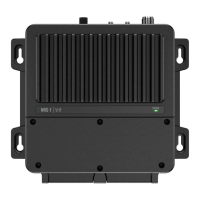mobile service using digitally modulated emissions and subject to coordination with affected
administrations. (WRC-15)
wa) In Regions 1 and 3:
• Until 1 January 2017, the frequency bands 157.025-157.175 MHz and 161.625-161.775 MHz
(corresponding to channels: 80, 21, 81, 22, 82, 23 and 83) may be used for digitally modulated
emissions, subject to coordination with affected administrations. Stations using these channels or
frequency bands for digitally modulated emissions shall not cause harmful interference to, or claim
protection from, other stations operating in accordance with Article 5.
• From 1 January 2017, the frequency bands 157.025-157.100 MHz and 161.625-161.700 MHz
(corresponding to channels: 80, 21, 81 and 22) are identified for utilization of the digital systems
described in the most recent version of Recommendation ITU-R M.1842 using multiple 25 kHz
contiguous channels.
• From 1 January 2017, the frequency bands 157.150-157.175 MHz and 161.750-161.775 MHz
(corresponding to channels: 23 and 83) are identified for utilization of the digital systems described
in the most recent version of Recommendation ITU-R M.1842 using two 25 kHz contiguous
channels. From 1 January 2017, the frequencies 157.125 MHz and 161.725 MHz (corresponding to
channel: 82) are identified for the utilization of the digital systems described in the most recent
version of Recommendation ITU-R M.1842.
• The frequency bands 157.025-157.175 MHz and 161.625-161.775 MHz (corresponding to channels: 80,
21, 81, 22, 82, 23 and 83) can also be used for analogue modulation described in the most recent
version of Recommendation ITU-R M.1084 by an administration that wishes to do so, subject to not
claiming protection from other stations in the maritime mobile service using digitally modulated
emissions and subject to coordination with affected administrations. (WRC-15)
ww) In Region 2:
• The frequency bands 157.200-157.325 and 161.800-161.925 MHz (corresponding to channels: 24, 84,
25, 85, 26 and 86) are designated for digitally modulated emissions in accordance with the most
recent version of Recommendation ITU-R M.1842. In Canada and Barbados, from 1 January 2019 the
frequency bands 157.200-157.275 and 161.800-161.875 MHz (corresponding to channels: 24, 84, 25
and 85) may be used for digitally modulated emissions, such as those described in the most recent
version of Recommendation ITU-R M.2092, subject to coordination with affected administrations.
( W R C-15)
x) From 1 January 2017, in Angola, Botswana, Lesotho, Madagascar, Malawi, Mauritius, Mozambique, Namibia,
Democratic Republic of the Congo, Seychelles, South Africa, Swaziland, Tanzania, Zambia and Zimbabwe,
the frequency bands 157.125-157.325 and 161.725-161.925 MHz (corresponding to channels: 82, 23, 83, 24,
84, 25, 85, 26 and 86) are designated for digitally modulated emissions.
• From 1 January 2017, in China, the frequency bands 157.150-157.325 and 161.750-161.925 MHz
(corresponding to channels: 23, 83, 24, 84, 25, 85, 26 and 86) are designated for digitally modulated
emissions. (WRC-12)
xx) From 1 January 2019, the channels 24, 84, 25 and 85 may be merged in order to form a unique duplex
channel with a bandwidth of 100 kHz in order to operate the VDES terrestrial component described in the
most recent version of Recommendation ITU-R M.2092. (WRC-15)
y) These channels may be operated as single or duplex frequency channels, subject to coordination with
affected administrations. (WRC-12)
z) Until 1 January 2019, these channels may be used for possible testing of future AIS applications without
causing harmful interference to, or claiming protection from, existing applications and stations operating
in the fixed and mobile services.
• From 1 January 2019, these channels are each split into two simplex channels. The channels 2027
and 2028 designated as ASM 1 and ASM 2 are used for application specific messages (ASM) as
described in the most recent version of Recommendation ITU-R M.2092. (WRC-15)
zx) In the United States,
• these channels are used for communication between ship stations and coast stations for the
purpose of public correspondence. (WRC-15)
zz) From 1 January 2019,
• channels 1027, 1028, 87 and 88 are used as single-frequency analogue channels for port operation
and ship movement. (WRC-15)
Source: ITU Radio Regulations ; reproduced with permission from ITU
| 73
Channel charts | RS100 / RS100-B / V100 / V100-B User Manual

